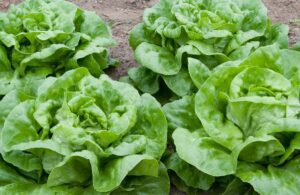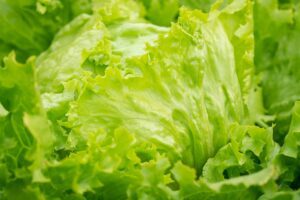Lettuce
Lettuce wax lyrical about this wonderful member of the daisy family Asteracea, shall we?
Lettuce is excellent for digestion and promotes good liver function. It can reduce the risk of heart attacks and is important for healthy eyesight. It contains good levels of Vitamin C, beta-carotene and fibre. Lettuce can also be used as a sedative, as its milky juice has been used as a sleep tonic for thousands of years.
There are thousands of varieties of lettuce, broadly grouped into 5 categories: Cos, aka Romaine (a mostly head forming type with elongated leaves, has a piquant flavour and is used in Caesar salads); Butterhead (popular in Europe, forms a soft and loose texture with a mild flavor), Iceberg/Crisphead (forms a tight and dense head like a cabbage and have the mildest flavor, used more for the crunchy texture and by far the most consumed lettuce variety due to the fast food industry); Loose Leaf (has delicate and mild flavoured leaves, easiest and least demanding lettuce to grow in home gardens) and Summer Crisp (form moderately dense heads and are somewhere between Loose Leaf and Iceberg).
- Cos Lettuce
- Butterhead Lettuce
- Iceberg Lettuce
- Loose Leaf Lettuce
- Summer Crisp Lettuce
To grow, use raised beds as these prevent root rot. As all leafy vegetables require nitrogen, it’s wise to have a good dressing of organic compost and animal manure (if using chicken manure don’t put it on too fresh as it’s very hot on young plants). Sow densely in shallow drills and thin the weaker seedlings out gradually so as not to crowd your “keepers”. The “keepers” are the strongest and healthiest quick growing plants – you want to hold on to your best genetic stock for seed saving or to develop your own lettuce adapted perfectly to your own climate. All seedlings removed can be used as salad greens.
Lettuce prefers cool weather but grows slowly over winter months. When temperatures are consistently above 20°C your lettuces can bolt to seed, leaving a more bitter leaf on the stalk, so for summer growing provide shade. As lettuce is shallow rooted it will require regular inputs of water with reasonable drainage. The best lettuce is that which grows quickly, so be sure to water and fertilise. One of the keys to growing lettuce well at home is to sow seeds every two weeks or so, therefore making sure you always have a good supply as they don’t store particularly well.
Aphids, caterpillars, and nematodes are the most common pests, and a fungal disease called chocolate spot is the main disease they suffer from. Use natural sprays and biologically rich soil improvers to ward off these problems.
Lettuce is best eaten within minutes of picking for maximum crispness and nutrition. Get more creative than just adding lettuce to your salad (or salad roll) by using them as wraps, as cups or enjoy in a refreshing cocktail!


















